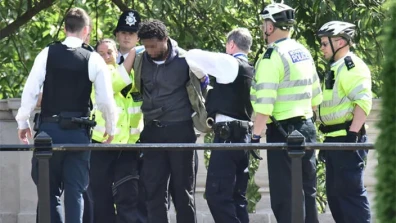Islam is the religion of peace and prosperity. Islam provides a complete code of life highlighted in the Quran and practically implemented by the Last Islamic Prophet Muhammad (Peace Be upon Him).
Offering obligatory prayer has the practical manifestation of following the religion of Islam and unconditional obedience to the will of God/ the lawgiver. How to pray maghrib or how to perform maghrib has frequently been asked due to the falling of the prayer time at the start of the night.
Generally, it is the fourth mandatory prayer in a day and is offered at the sunset hour of the day. This time has been defined as a period when the redness of the east disappears.
Table of Contents
- Scope of the Religious Ordains
- What is Salah (Islamic Prayers)?
- Individual Prayer & Prayer in the Mosque
- Types of Prayers in Islam
- Purpose of Salah
- What is the Maghrib Prayer?
- Significance of Maghrib Prayer in Islam
- Raka’ats and Time of Maghrib Prayer?
- Maghrib Prayer Time: School of thoughts
- Conditions Precedents for the Maghrib Prayer
- Steps to Pray Maghrib
- Begin First rakat with the Surah al-Fatiha
- Reciting other sections of the Quran
- Enter the Ruku and Praise to Allah
- Returning to Qiyam
- Entering the Sujood
- Rise in Juloos
- Complete the First Rakat by Entering Sujood
- Repeat the Same Process for Second Rakat
- Reciting Tashahud
- Perform the Third Rakat
- Perform Sunnah as per Your Liking
- End Prayer with Taslim
- Conclusion
- Frequently Asked Question
Scope of the Religious Ordains
The religion of Islam highlights and covers every aspect of life. It shows and enlightens mankind about how you could become successful not only in this world but also in life hereafter. Islam focuses on giving all the rights to the entire creatures living in the galaxies, planets and so on.
For humans, the religion of Islam has given complete guidance with the divine authority to act upon the injunction of Islam to become successful in life and also in the hereafter (as per the belief of the Muslim). For in-depth analysis on the significance of injunctions of Islam; you can read article How to Pray Istikhara
What is Salah (Islamic Prayers)?
The salah is a special form of worship that is the second most important pillar of Islam after the shahada (testimony of faith). It is an obligatory form of prayer performed five times a day that was revealed in the Holy Qur’an and taught to us by Prophet (peace be upon him).
The salah involves a number of physical movements – standing, bowing, prostrating, and sitting. It also involves the recitation of verses from the Holy Quran in Arabic along with a number of dua (supplications).
The Muslim will face the direction of the Kaba, the Sacred House of Allah in Makkah, whenever they perform their prayer. These physical movements, recitations, and supplications are all done to show humility and submission to Allah.
There are many verses in the Holy Quran which Allah tells us about the importance of prayer. One such verses says: -
Recite, [O Muhammad], what has been revealed to you of the Book and establish prayer. Indeed, prayer prohibits immorality and wrongdoing, and the remembrance of Allah is greater. And Allah hears and knows that which you do. (29:45).
The purpose of Salah is to purify the soul by connecting an individual to Allah Subhana Wa Taala. Prayers (Salah) is the only type of Islamic worship that was given and blessed in the heavens.
Ablution is the key necessity before prayers, without which prayer cannot be performed until the conditions warrant otherwise. The names of the five prayers are Salah al-fajar, al-zuhr, al-asr, al-maghrib, and al-isha.
Individual Prayer & Prayer in the Mosque
Muslims are permitted to perform the salah individually however they are preferred to offer it in the company of other Muslims in the mosque. The individuals turn their direction towards the Kaaba (Holy Shrine) in Makkah to offer any of the prayers.
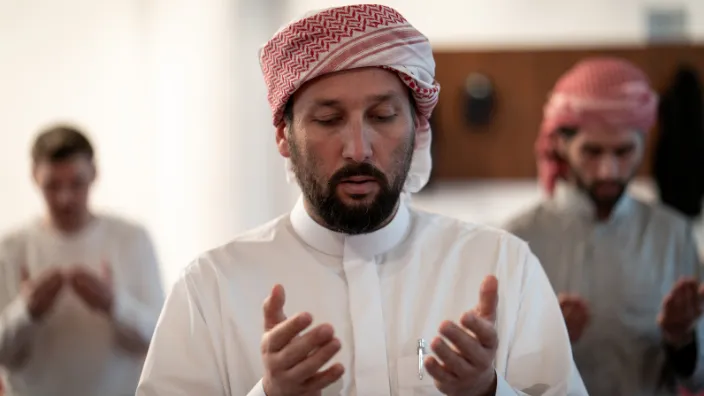
In the case of prayer in the mosque, the imam is a prayer leader who leads by directing the rak’ahs which are Quranic recitations accompanied by physical postures followed by all others standing in the back rows of the imam.
On the day of Friday, the offering of a congregational prayer takes place instead of the afternoon prayers. The congregational prayer is called Salat al-Jum’ah. This salat consists of the delivery of two sermons from the pulpit.
Types of Prayers in Islam
There are four types of prayers in Islam. The prayers have been divided into four types considering the worth, requirement, and necessity of each prayer.
- Fard (Obligatory prayer)
- Wajib (Required prayer)
- Sunnah (Necessary Prayer)
- Nafl (Voluntary prayers)
Concerning Fard prayer, all the Sunni schools of thought in Islam consider fard as an obligatory prayer which no Muslim could leave. Muslims have an obligation to perform obligatory prayers.
Non-observance of these prayers makes a Muslim sinner. This type of prayer is offered five times a day within the difference of a few hours. To pray Maghrib prayer or salah al maghrib is also included in the obligatory prayers.
Wajib term also refers to a prayer like an obligatory prayer and the person again is sinful if he misses any of these prayers. There is a certain difference in the opinions of the scholars of Islam; however, there is qada as a replacement for the fard prayer but it is not the case with the wajib prayer.
Sunnah is a third type of prayer in the right foot step of Prophet Muhammad (PBUH). These prayers are also considered mandatory.
However, the act of missing these prayers is censurable in case of intentional missing while there is no penalty for missing this prayer.
Nafl is voluntary prayer that is offered to get extra virtue from Allah (SWT). Missing Nafl prayers is not sinful at all but one cannot get close to the lawgiver without becoming in the habit of offering this additional prayer. The more nafl prayers you offer, the more you get rewarded.
Purpose of Salah
Abu Huraira reported: “The Messenger of Allah, peace and blessings be upon him, said, ‘The first action for which a servant of Allah will be held accountable on the Day of Resurrection will be his prayers. If they are in order, he will have prospered and succeeded.
If they are lacking, he will have failed and lost. If there is something defective in his obligatory prayers, then the Almighty Lord will say: See if my servant has any voluntary prayers that can complete what is insufficient in his obligatory prayers. The rest of his deeds will be judged the same way.’” (Sunan al-Tirmidhī)
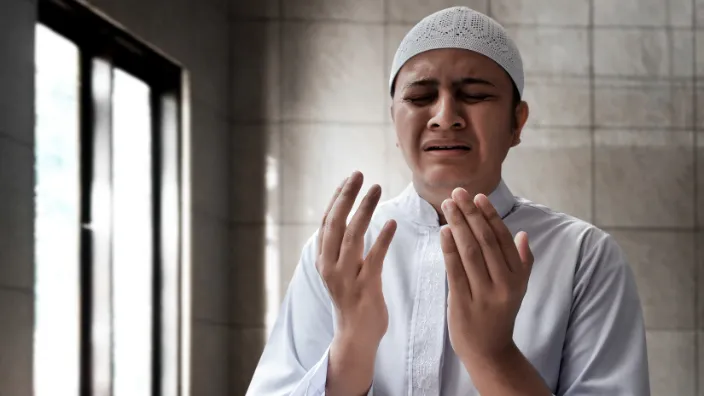
The main purpose of Salah is the remembrance of Allah and to disconnect from the world. When Allah introduces Himself to Musa (A), the first thing He says to him is: “Worship Me” and “Establish prayer for My remembrance.” When we stand up to pray, how often is our heart present? How often do we think to ourselves: I am going to now remember Allah? I am going to have a conversation with Allah?
When we have the advantage of speaking with someone we adore, we rush to the phone. We talk to them for a long time and don’t like anyone to disturb us. But when it comes to conversing with Allah, do we have that same zeal to rush to the salah?
Allah made it so clear and simple for us to comprehend the purpose of salah in this ayah. The purpose of salah is to remember Allah, to talk to Him, to connect with Him.
After mentioning salah, Allah reminds Musa (and us) that the Day of Judgement is coming that is mentioned in the Qur’an.
The purpose of salah is maintaining devotion and faith in Allah. Its purpose is to raise the level of your taqwa (piousness). There are different physical movements while supplication in salah.
These movements include bowing, standing, and prostrating. Salah includes reciting the Quranic verses in Arabic and after the salah, there is a dua that are supplications.
Physical movements of Muslims during salah along with recitations are to demonstrate submission to Allah and humility. The salah was included as the first commandment in Islam after the Prophecy of the Prophet Muhammad (PBUH), which shows its highest significance in the religion of Islam.
What is the Maghrib Prayer?
To perform Maghrib prayer is one of the obligatory five daily prayers for a Muslim. It is also called sunset prayer due to its evening-time prayer.
It is recommended to offer the prayer in the mosque; however if due to some reasons including mobility, one can offer it at home, residence or the place of living.
Further, Together, these five obligatory prayers, also known as Salah or Namaaz, are the second pillar of Islam. Maghrib salah or salah al maghrib is also known as the sunset prayer, since this is the time of day during which it takes place, and the word “maghrib” means “sunset in Arabic.”
Prayer has a lot of benefits in Islam—it built your relationship with Allah, clean your sins, and gives you the opportunity to practice self-reflection, introspection and grow spiritually.
Significance of Maghrib Prayer in Islam
The significance of the Maghrib prayer can be gauged from the injunctions of Islam typically given in the verses of the Holy Quran and discussed in the traditions of the Holy Prophet (PBUH). Surah Isra in its verse no 78 finds mentioned as follows: -
أَقِمِ الصَّلَاةَ لِدُلُوكِ الشَّمْسِ إِلَىٰ غَسَقِ اللَّيْلِ وَقُرْآنَ الْفَجْرِ ۖ إِنَّ قُرْآنَ الْفَجْرِ كَانَ مَشْهُودًا
Establish prayer at the decline of the sun [from its meridian] until the darkness of the night and [also] the Qur’an of dawn. Indeed, the recitation of dawn is ever witnessed.
Holy Prophet Muhammad (PBUH) placed much focus on the Maghrib prayer and its offering by the Muslims; however, some of the traditions (by way of English translation) are given below for quick reference: -
-The prophet Muhammad (PBUH) said Maghrib (prayer) is the Witr (prayer) of the day.
-As Narrated by Anas ‘ I saw the most famous people amongst the companions of the Prophet (PBUH) hurrying towards the pillars at the maghrib prayer before the prophet came for the prayer.
The above narrative shows the importance of the Maghrib prayer in the life of Muslims. It has been considered a prayer of utmost worth offered at the end of the day, and start of the night.
Raka’ats and Time of Maghrib Prayer?
A prayer unit is known as rakat. Muslims follow a series of actions and prayers consisting of rakats. Leaving an obligatory prayer is considered a sin in Islam. Therefore, one should not leave the prayer except in dire emergencies in which the replacement has been allowed.
In the Maghrib prayer, there are 3 obligatory rakats, while 2 rakats Sunnah and 2 rakats as nafl, which are performed in two sets after the performance of the obligatory 3 rakats.
Maghrib Prayer Time: School of thoughts
The time of Maghrib prayer starts when the prescribed time for the performance of the Asr prayer ends and the sun completely sinks into the horizon. Maghrib start and end time has gained significance due to divergence of opinions, explained as follows:
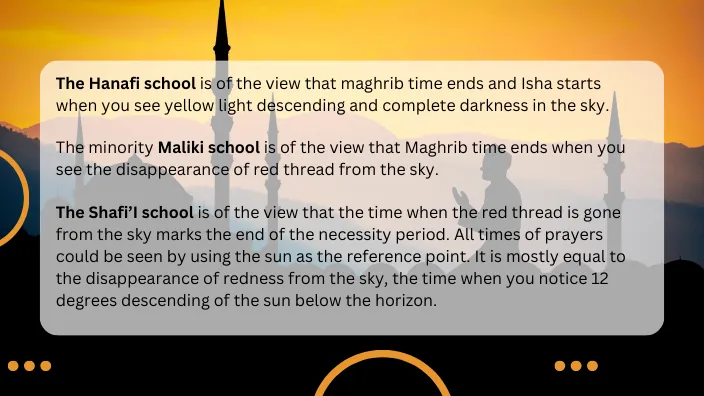
Conditions Precedents for the Maghrib Prayer
When we are preparing for prayer, we should keep in mind so that our awareness is concentrated on the goal of attaining and purifying our hearts.
Related to this inward purification is the purification from sin, as prayer is among the greatest good deeds for which we expiate our sins.
Abdullah ibn Mas’ud reported: “A man kissed a woman who was not his wife and he came to the Messenger of Allah, peace and blessings be upon him, and told him about that.”
The verse was revealed: -
“Establish prayer at the two ends of the day and in the first hours of the night. Verily, good deeds will do away with bad deeds.” (11:114)
Like any other prayer, every Muslim is required to observe a few of the pre-conditions so the prayer can be accepted by Allah (SWT). The key requirements include the following: -
Purification
Purifying oneself with wudhu or ghusl is the main requirement. Without that, a Muslim could not perform any of his prayers.
This is due to the possibility that you might have passed gas, used your restroom, entered deep sleep, and might have touched your sexual organs.
In case time has passed when you have got your wudu in the past or if you have been involved in any sexual activity then it is compulsory for a Muslim to perform ghusl. In that case, without a ghusl, offering prayers is prohibited.
Thus, The ablution with water (wudu), which itself precedes the prayer, represents this process of repentance and purification. When we do ablution, we should keep in mind that the sincerity and purity of our act is washing the sin from our souls with every drop of water.
Abu Huraira reported: The Messenger of Allah, peace and blessings be upon him, said:
“When a Muslim or a believer washes his face in ablution, then every sin which he committed with his eyes will be washed away with the last drop of water.
When he washes his hands, then every sin which he committed with his hands will be washed away with the last drop of water. When he washes his feet, then every sin which he committed with his feet will be washed away with the last drop of water until he emerges purified from sin.”
Modest Clothing
Men and women both are required to have modest clothing and not tight dresses like you have worn any fashion-oriented dress.
You need to cover your body. However, men should be unleashing their ankles but the females should not. This is the way in which you have to look.
For the prayers, Muslim men wear clothing which covers the front side of their body as well as the backside between their knees and the navels.
On the other hand, women are required to cover their entire body parts except the face and hands. Lose dress is, therefore, mandatory.
Facing the Qibla
It is required for Muslims to face Qibla which is the Kaaba in Makkah. If you are at some new place, there are different apps available that tell you the direction of Qibla.
Steps to Pray Maghrib
The time of maghrib prayer is after sunset and it is a very important obligation in religion. Prayer is a very soulful spiritual and beautiful obligation, which is offered by Muslims around the world.
The question is in what way do you offer your Maghrib prayers Following are the ways in which you will offer Maghrib prayer. Maghrib prayer steps are: -
Making the Niyat of Maghrib Prayer is the first stage to perform Maghrib prayers is to have your intention to perform Maghrib prayer. Niyat is the word used for intending to perform prayers. It is the first part of prayers.
It is not necessary that you only have to intend in the Arabic language. You can say it in English too. The intention words could be like “I intend to perform 3 rakat of Maghrib prayers today.”
Entering Qyam and Saying Takbir refers to your standing position while folding your hands to the ears.

Doing this, your palms should be faced outwards. You will then recite “Allahu Akbar” which is Takbir, meaning God is Great.
Reciting the Opening Supplication start their supplication with a short dua which is a sunnah. Sunnah are the actions which the Prophet Muhammad (PBUH) practiced.
The meaning of the dua is that “O Allah you are Glorious, with your praising and your name is blessed as well as exalted. None should be worshipped except you, Your Majesty.
Praying for Refuge from Devil Shaitan is begining of your first rakat, warding off shaitan is a customary practice which is a malevolent entity working against the will of Allah.
For this purpose, recite the following prayer: Meaning: “I opt for refuge with Allah against the accursed Devil Shaitan.”
Begin First rakat with the Surah al-Fatiha
Remember that each rakat starts with a Surah al-Fatiha recitation. After its recitation, say “Ameen” which means “I affirm the truth of Allah”. The meaning of Surah al-Fatiha is mentioned below: -
“With the name of Allah, the merciful. Praise be to Allah, the entire world’s Lord, Very and all-merciful. The Day of Requital’s Master. Only do we worship and only from you do we seek help.
Lead us to the straight path, the way on which you have bestowed the grace and not on which you have shown your wrath, neither in those that have gone astray.
Reciting other sections of the Quran
You will then select another Quranic surah for your first two Rakat. In the case of a starter, you must begin with a shorter one. The short one could be memorized easily.
Therefore, it is beneficial in terms of memorizing to recite shorter ones first. A medium one could be recited if you could easily memorize the longer versions of surah in the Quran.
For reference purposes, we can quote surah al-Naas meaning: “Say, I seek refuge in the Lord of mankind, the Sovereign of mankind, the God of mankind, from the evil of retreating whisperers, who whisper evil in mankind’s breasts among jinn and mankind.”
Enter the Ruku and Praise to Allah
Ruku refers to the bowing position in which an individual leans forward with straight legs. You will position your torso parallel to the ground, and with your hands on the knees.
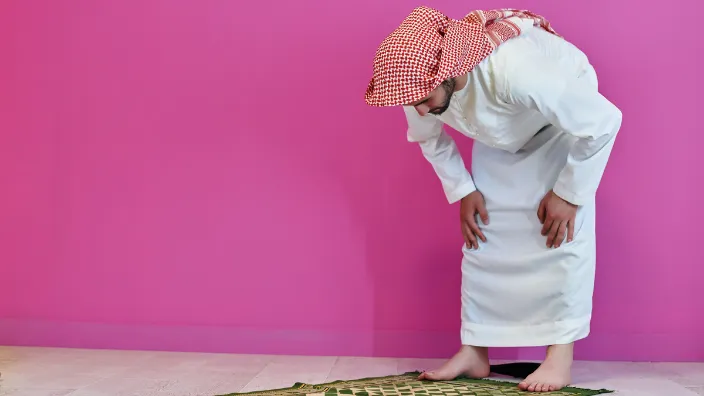
While moving into that position, also say “Allah o Akbar”, then repeat the following process 3, 5 or 7 times in the prayers once you are in Ruk’u and say “Subhaana rabbiyal’atheem”, which means “Glory to my Supreme God.”
Returning to Qiyam
Then you will rise to the standing position which is called Qyam again. While doing this you should be reciting “Our Lord and to you the praise belongs.”
This you will be doing in your standing position. For a small time, you need to stay this time before going down to offer sujood.
Entering the Sujood
Then you will enter sujood. Sujood is actually a prostrating position in which you lower yourself with knees, forehead and nose touching the floor.
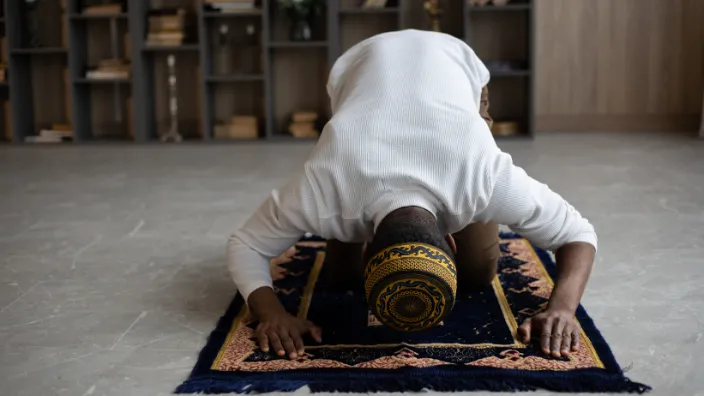
You will then place your palms beside your head and on the floor too. You will then say “Allahu Akbar.” Repeat the process 3 times with “Subhana rabbiyal ‘aala’, which means “Glory to my Most High Lord.”
Rise in Juloos
Sitting on your knee is called the Juloos position. In this position, you will place all your weight on the left thigh while facing the right-side toes to Qibla as well as hands put on the knees.
While entering Juloos you will say “Allahu Akbar.” After coming back to the sitting position you will be repeating 3 times the following: “O Allah, please forgive us.”
Complete the First Rakat by Entering Sujood
You will return to the state of prostration by touching your nose and forehead on the floor. During this, you will say “Allahu Akbar.” You will then repeat this procedure 3 times in sujood to complete the first rakat. Meaning: “Glory to my Most High Lord.”
Repeat the Same Process for Second Rakat
All the steps mentioned above, you are supposed to repeat for the second rakat too by adding Tashahud as it ends.
However, while being in Qiyam, you should recite surah al-Fatiha this time again followed by some other Quranic verse after the recitation of Surah al-Fatiha.
Reciting Tashahud
You will recite Tashahud after the second rakat, rising from Sujood and going back to Juloos in the sitting position.
Tashahud is performed twice in the prayers involving Three or Four rakats of obligatory prayer, while in the prayers where only two rakats are kept obligatory, it is performed once after the second rakat.
Perform the Third Rakat
Begin your third rakat after you have finished Tashahud. You will start by reciting Surah al-Fatiha in Qiyam. Remember that other than Surah al-Fatiha, you don’t have to recite any extra surah.
Perform Sunnah as per Your Liking
When the third rakat is completed, you will have finished the required rakats in the Maghrib prayers. You could go for 2 additional rakats totalling 5 rakats.
You will not need to recite any surah other than surah al-Fatiha while remembering that Tashahud is a conventional performance after the additional rakat.
End Prayer with Taslim
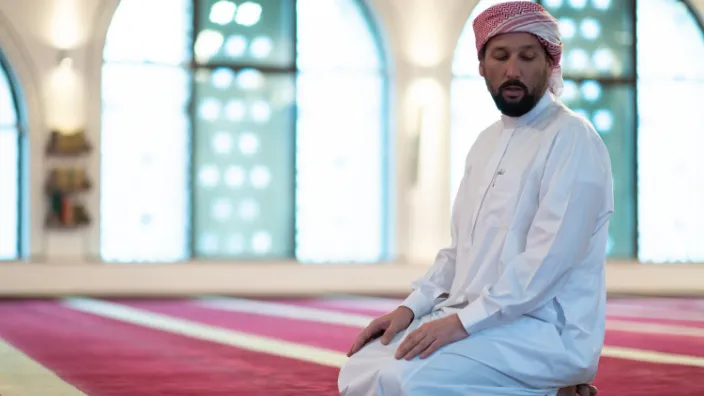
When you finish completing the rakat either 3 or 5 then you can end your prayers. Turn the head to the right side while sitting in Juloos and say “May the mercy and peace of Allah be upon you.” Turn your head to the left side and say the same phrase. Your Maghrib prayer is complete.
Conclusion
Performing Maghrib prayers is not difficult if you have understood all the steps well before practical application in prayers.
The time to offer Maghrib prayer lies during the sunset and consists of a total of 7 Rakats including 3 Fard, 2 Sunnah and 2 Nafl rakats.
Answering to the question ‘how to pray Maghrib’ we have given sufficient details describing the physical postures and supplications with Quranic Surah recitations.
The Maghrib prayer has many spiritual benefits as it connects your heart and soul to Allah Almighty, the God and creator of the entire universe and mankind.
Frequently Asked Question
Do you pray sunnah before or after maghrib?
Following the traditions of the Holy Prophet (PBUH), Muslims offer 2 rakats Sunnah after obligatory rakats of Maghrib prayer. There is no source or practice of offering Sunnah prayer before offering the Farz rakats.
How is Maghrib prayer performed?
Like any other obligatory prayer, Maghrib prayer should be offered in the mosque with other Muslims, however if it becomes difficult, it can be offered at home or any other dwelling place in the same pattern starting from takbir e tehrima, qiyam, ruku, sajda, ending on tasleem.
How many Rakats are in maghrib?
Seven rakats are performed in the maghrib prayer. The composition of seven rakats is like 3 rakats are mandatory (fard), while two rakats are Sunnah, followed by two rakats as nafls.













